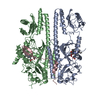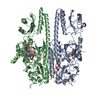[English] 日本語
 Yorodumi
Yorodumi- PDB-8yb4: Pfr conformer of Arabidopsis thaliana phytochrome B in complex wi... -
+ Open data
Open data
- Basic information
Basic information
| Entry | Database: PDB / ID: 8yb4 | ||||||
|---|---|---|---|---|---|---|---|
| Title | Pfr conformer of Arabidopsis thaliana phytochrome B in complex with phytochrome-interacting factor 6 | ||||||
 Components Components |
| ||||||
 Keywords Keywords | GENE REGULATION / phytochrome / phytochrome interaction factor / signal complex / SIGNALING PROTEIN | ||||||
| Function / homology |  Function and homology information Function and homology informationabscisic acid metabolic process / response to low fluence red light stimulus / red light photoreceptor activity / protein-phytochromobilin linkage / transpiration / red or far-red light signaling pathway / regulation of defense response / far-red light photoreceptor activity / red light signaling pathway / circadian regulation of calcium ion oscillation ...abscisic acid metabolic process / response to low fluence red light stimulus / red light photoreceptor activity / protein-phytochromobilin linkage / transpiration / red or far-red light signaling pathway / regulation of defense response / far-red light photoreceptor activity / red light signaling pathway / circadian regulation of calcium ion oscillation / response to low fluence blue light stimulus by blue low-fluence system / red or far-red light photoreceptor activity / regulation of photoperiodism, flowering / stomatal complex development / gravitropism / phototropism / regulation of seed germination / jasmonic acid mediated signaling pathway / response to far red light / photomorphogenesis / entrainment of circadian clock / response to abscisic acid / detection of visible light / response to salt / response to temperature stimulus / phosphorelay sensor kinase activity / response to light stimulus / photosynthesis / response to cold / promoter-specific chromatin binding / chromatin organization / sequence-specific DNA binding / protein dimerization activity / nuclear speck / nuclear body / DNA-binding transcription factor activity / negative regulation of DNA-templated transcription / protein homodimerization activity / DNA binding / identical protein binding / nucleus / cytosol Similarity search - Function | ||||||
| Biological species |  | ||||||
| Method | ELECTRON MICROSCOPY / single particle reconstruction / cryo EM / Resolution: 3.1 Å | ||||||
 Authors Authors | Wang, Z. / Wang, W. / Zhao, D. / Song, Y. / Xu, B. / Zhao, J. / Wang, J. | ||||||
| Funding support |  China, 1items China, 1items
| ||||||
 Citation Citation |  Journal: Cell / Year: 2024 Journal: Cell / Year: 2024Title: Light-induced remodeling of phytochrome B enables signal transduction by phytochrome-interacting factor. Authors: Zhengdong Wang / Wenfeng Wang / Didi Zhao / Yanping Song / Xiaoli Lin / Meng Shen / Cheng Chi / Bin Xu / Jun Zhao / Xing Wang Deng / Jizong Wang /  Abstract: Phytochrome B (phyB) and phytochrome-interacting factors (PIFs) constitute a well-established signaling module critical for plants adapting to ambient light. However, mechanisms underlying phyB ...Phytochrome B (phyB) and phytochrome-interacting factors (PIFs) constitute a well-established signaling module critical for plants adapting to ambient light. However, mechanisms underlying phyB photoactivation and PIF binding for signal transduction remain elusive. Here, we report the cryo-electron microscopy (cryo-EM) structures of the photoactivated phyB or the constitutively active phyB mutant in complex with PIF6, revealing a similar trimer. The light-induced configuration switch of the chromophore drives a conformational transition of the nearby tongue signature within the phytochrome-specific (PHY) domain of phyB. The resulting α-helical PHY tongue further disrupts the head-to-tail dimer of phyB in the dark-adapted state. These structural remodelings of phyB facilitate the induced-fit recognition of PIF6, consequently stabilizing the N-terminal extension domain and a head-to-head dimer of activated phyB. Interestingly, the phyB dimer exhibits slight asymmetry, resulting in the binding of only one PIF6 molecule. Overall, our findings solve a key question with respect to how light-induced remodeling of phyB enables PIF signaling in phytochrome research. | ||||||
| History |
|
- Structure visualization
Structure visualization
| Structure viewer | Molecule:  Molmil Molmil Jmol/JSmol Jmol/JSmol |
|---|
- Downloads & links
Downloads & links
- Download
Download
| PDBx/mmCIF format |  8yb4.cif.gz 8yb4.cif.gz | 226.5 KB | Display |  PDBx/mmCIF format PDBx/mmCIF format |
|---|---|---|---|---|
| PDB format |  pdb8yb4.ent.gz pdb8yb4.ent.gz | 159.7 KB | Display |  PDB format PDB format |
| PDBx/mmJSON format |  8yb4.json.gz 8yb4.json.gz | Tree view |  PDBx/mmJSON format PDBx/mmJSON format | |
| Others |  Other downloads Other downloads |
-Validation report
| Summary document |  8yb4_validation.pdf.gz 8yb4_validation.pdf.gz | 1.5 MB | Display |  wwPDB validaton report wwPDB validaton report |
|---|---|---|---|---|
| Full document |  8yb4_full_validation.pdf.gz 8yb4_full_validation.pdf.gz | 1.5 MB | Display | |
| Data in XML |  8yb4_validation.xml.gz 8yb4_validation.xml.gz | 43.6 KB | Display | |
| Data in CIF |  8yb4_validation.cif.gz 8yb4_validation.cif.gz | 64.3 KB | Display | |
| Arichive directory |  https://data.pdbj.org/pub/pdb/validation_reports/yb/8yb4 https://data.pdbj.org/pub/pdb/validation_reports/yb/8yb4 ftp://data.pdbj.org/pub/pdb/validation_reports/yb/8yb4 ftp://data.pdbj.org/pub/pdb/validation_reports/yb/8yb4 | HTTPS FTP |
-Related structure data
| Related structure data |  39108MC  9iuzC M: map data used to model this data C: citing same article ( |
|---|---|
| Similar structure data | Similarity search - Function & homology  F&H Search F&H Search |
- Links
Links
- Assembly
Assembly
| Deposited unit | 
|
|---|---|
| 1 |
|
- Components
Components
| #1: Protein | Mass: 129884.500 Da / Num. of mol.: 2 Source method: isolated from a genetically manipulated source Source: (gene. exp.)   #2: Protein | | Mass: 11688.068 Da / Num. of mol.: 1 Source method: isolated from a genetically manipulated source Source: (gene. exp.)   #3: Chemical | Has ligand of interest | Y | Has protein modification | Y | |
|---|
-Experimental details
-Experiment
| Experiment | Method: ELECTRON MICROSCOPY |
|---|---|
| EM experiment | Aggregation state: PARTICLE / 3D reconstruction method: single particle reconstruction |
- Sample preparation
Sample preparation
| Component |
| |||||||||||||||||||||||||
|---|---|---|---|---|---|---|---|---|---|---|---|---|---|---|---|---|---|---|---|---|---|---|---|---|---|---|
| Molecular weight |
| |||||||||||||||||||||||||
| Source (natural) |
| |||||||||||||||||||||||||
| Source (recombinant) |
| |||||||||||||||||||||||||
| Buffer solution | pH: 8 | |||||||||||||||||||||||||
| Buffer component |
| |||||||||||||||||||||||||
| Specimen | Conc.: 1.5 mg/ml / Embedding applied: NO / Shadowing applied: NO / Staining applied: NO / Vitrification applied: YES | |||||||||||||||||||||||||
| Specimen support | Grid material: GOLD / Grid mesh size: 300 divisions/in. / Grid type: Quantifoil R1.2/1.3 | |||||||||||||||||||||||||
| Vitrification | Instrument: FEI VITROBOT MARK IV / Cryogen name: ETHANE / Humidity: 100 % / Chamber temperature: 277 K |
- Electron microscopy imaging
Electron microscopy imaging
| Experimental equipment |  Model: Titan Krios / Image courtesy: FEI Company |
|---|---|
| Microscopy | Model: FEI TITAN KRIOS |
| Electron gun | Electron source:  FIELD EMISSION GUN / Accelerating voltage: 300 kV / Illumination mode: FLOOD BEAM FIELD EMISSION GUN / Accelerating voltage: 300 kV / Illumination mode: FLOOD BEAM |
| Electron lens | Mode: BRIGHT FIELD / Nominal magnification: 105000 X / Nominal defocus max: 2000 nm / Nominal defocus min: 1000 nm / Cs: 2.7 mm |
| Specimen holder | Cryogen: NITROGEN / Specimen holder model: FEI TITAN KRIOS AUTOGRID HOLDER |
| Image recording | Average exposure time: 2.41 sec. / Electron dose: 50 e/Å2 / Film or detector model: GATAN K3 (6k x 4k) |
| EM imaging optics | Energyfilter name: GIF Bioquantum / Energyfilter slit width: 10 eV |
- Processing
Processing
| EM software |
| ||||||||||||||||||||||||||||||||||||||||||||
|---|---|---|---|---|---|---|---|---|---|---|---|---|---|---|---|---|---|---|---|---|---|---|---|---|---|---|---|---|---|---|---|---|---|---|---|---|---|---|---|---|---|---|---|---|---|
| CTF correction | Type: PHASE FLIPPING AND AMPLITUDE CORRECTION | ||||||||||||||||||||||||||||||||||||||||||||
| Symmetry | Point symmetry: C1 (asymmetric) | ||||||||||||||||||||||||||||||||||||||||||||
| 3D reconstruction | Resolution: 3.1 Å / Resolution method: FSC 0.143 CUT-OFF / Num. of particles: 325483 / Symmetry type: POINT | ||||||||||||||||||||||||||||||||||||||||||||
| Atomic model building | Protocol: RIGID BODY FIT / Space: REAL | ||||||||||||||||||||||||||||||||||||||||||||
| Atomic model building | 3D fitting-ID: 1 / Source name: AlphaFold / Type: in silico model
| ||||||||||||||||||||||||||||||||||||||||||||
| Refine LS restraints |
|
 Movie
Movie Controller
Controller



 PDBj
PDBj









